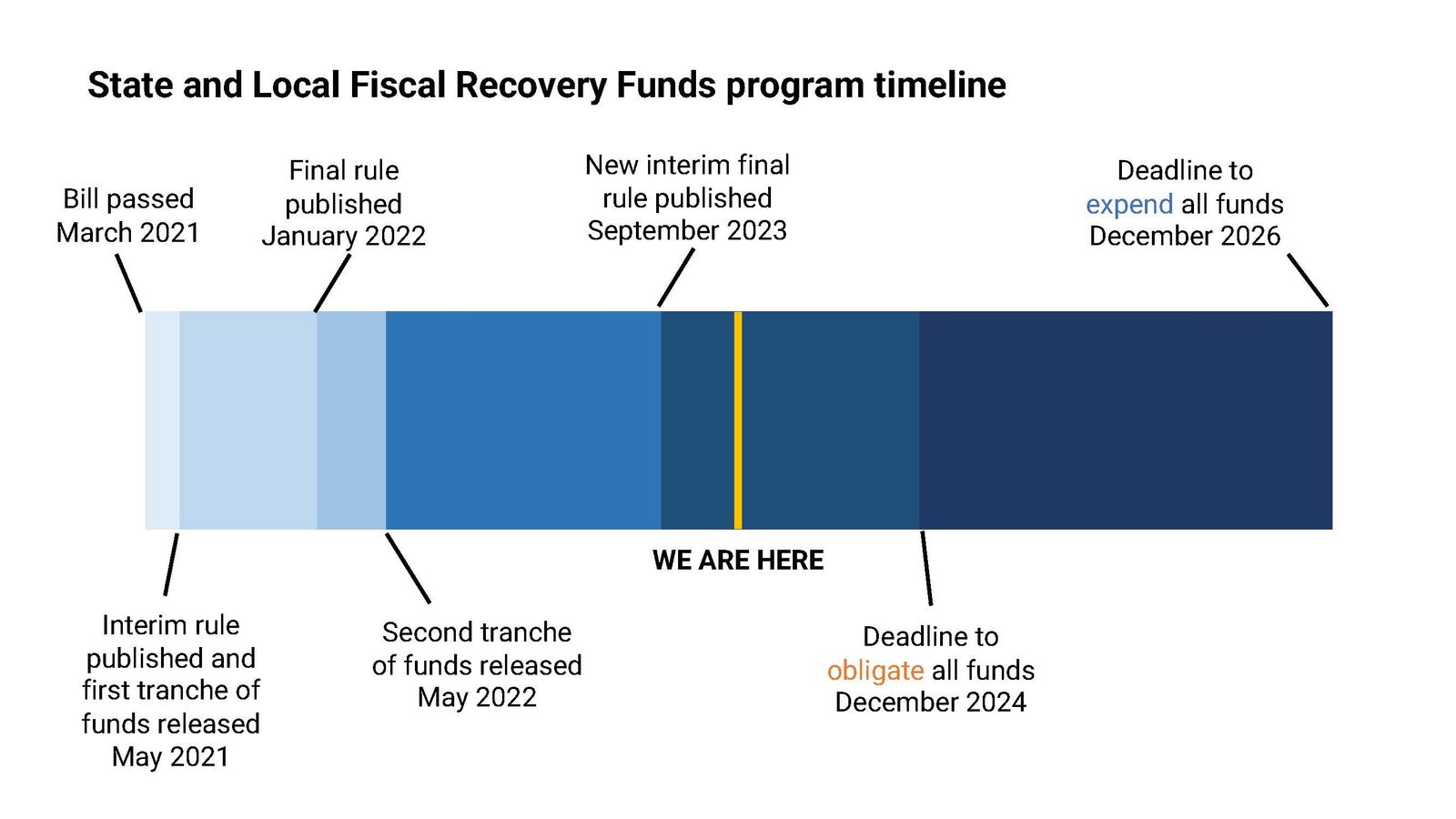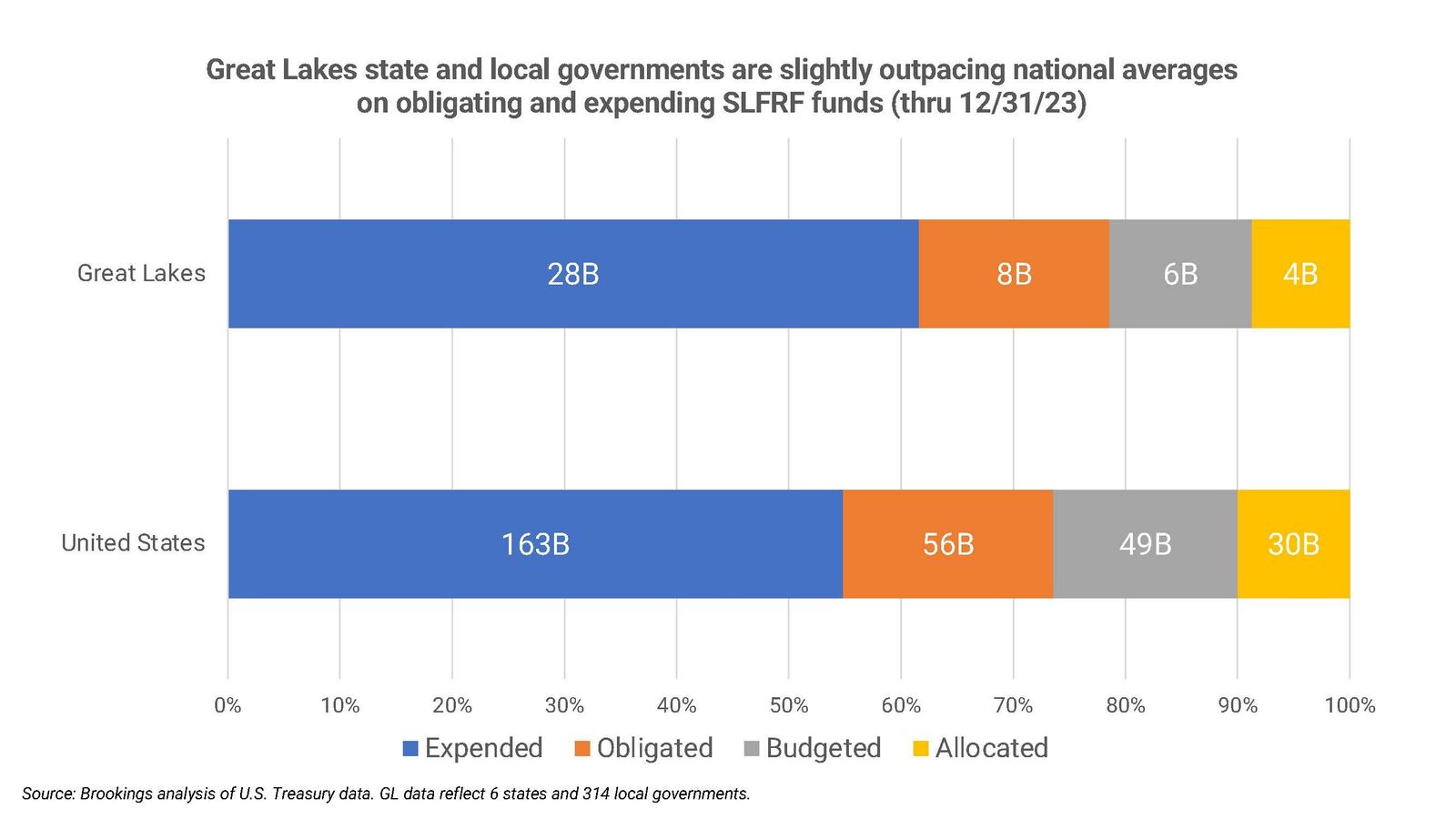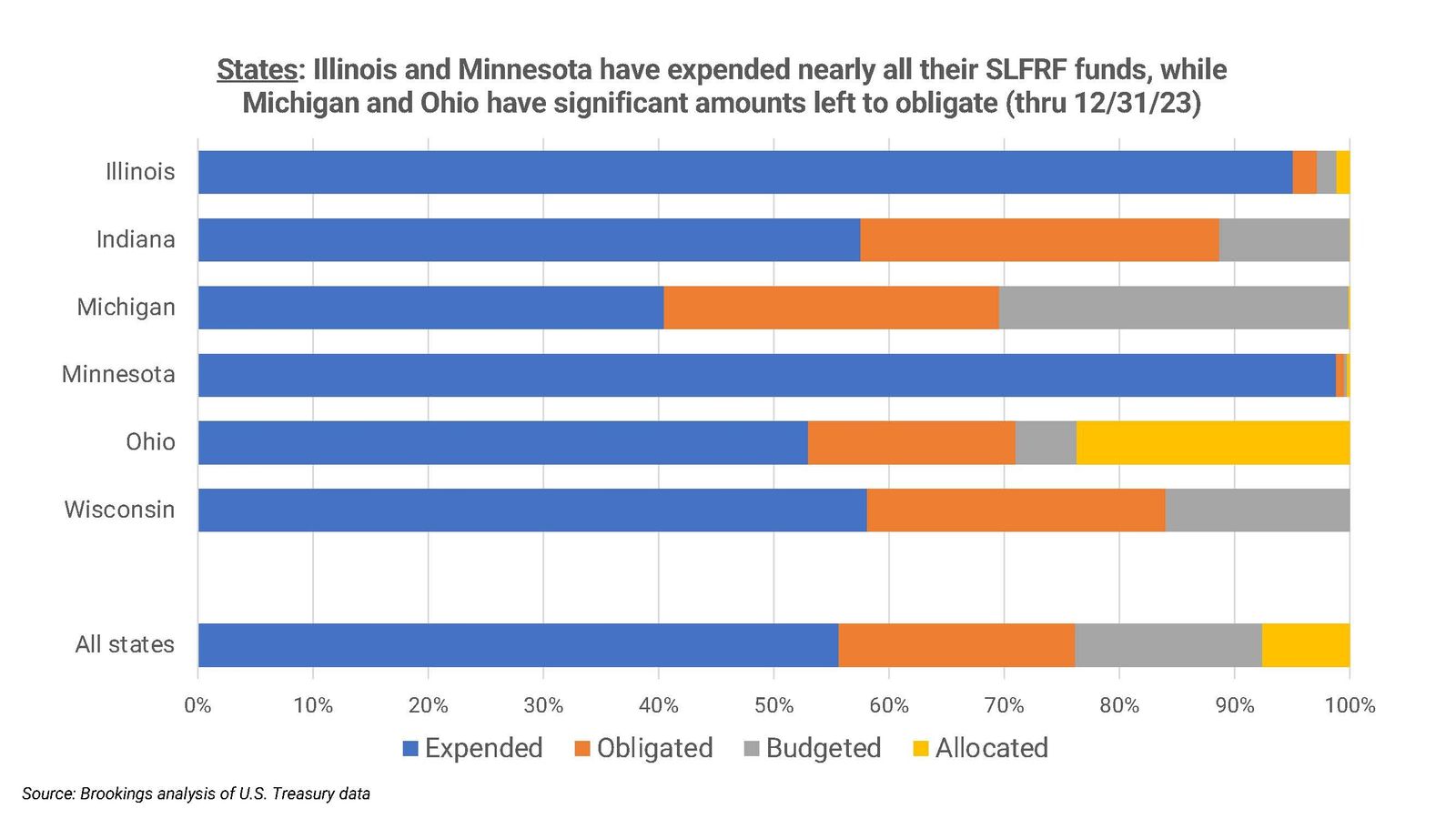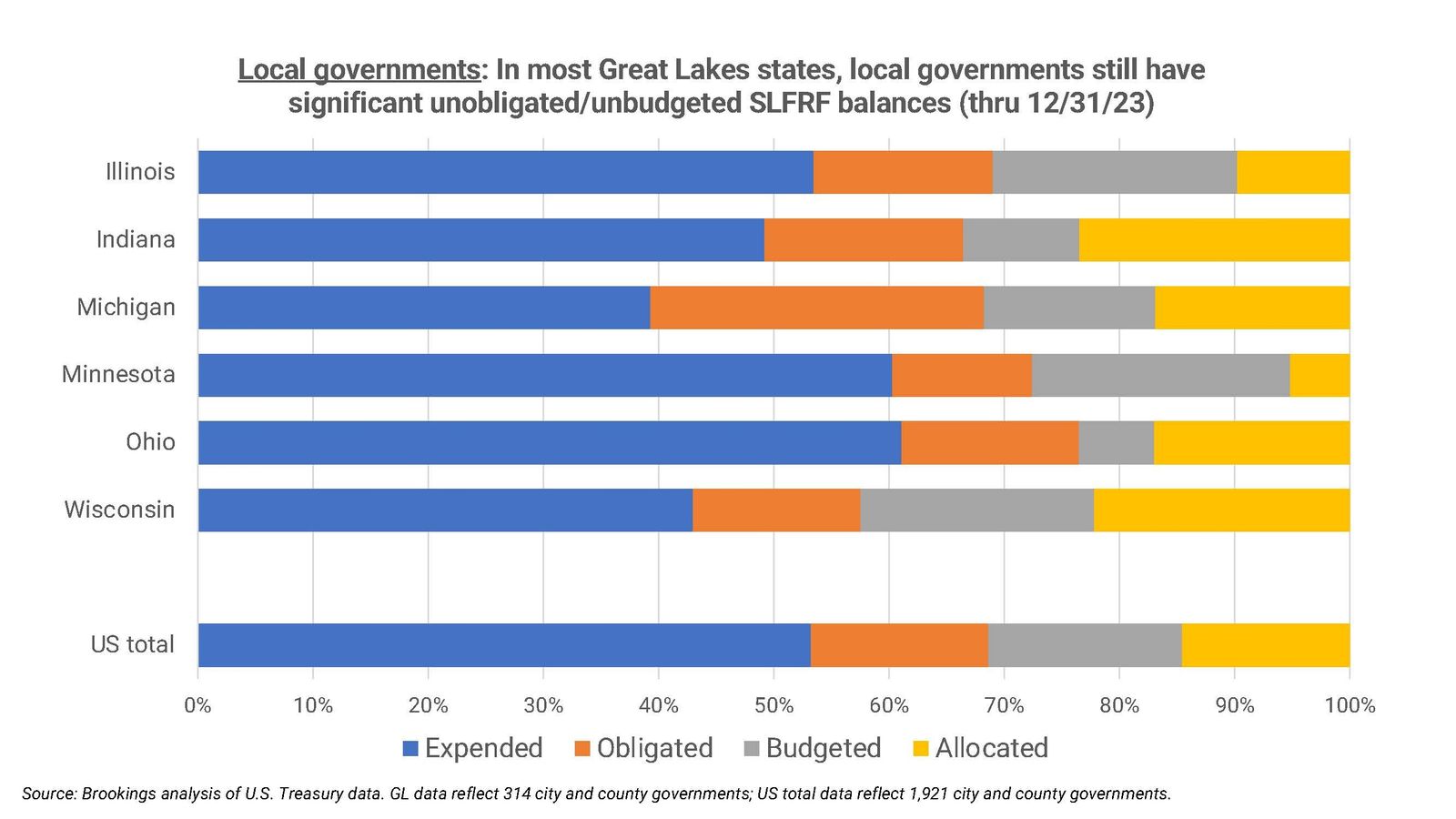This post was created through a collaborative effort between the Joyce Foundation and Brookings Metro. For more information, please contact Alan Berube at Brookings Metro or Amrit Mehra at the Joyce Foundation.
March 2024 marked the third anniversary of the passage of the American Rescue Plan Act (ARPA), including its transformative $350 billion Coronavirus State and Local Fiscal Recovery Funds (SLFRF) program. That program provided substantial, flexible funding to states, counties, and cities around the country to address the health, economic, and fiscal impacts of the COVID-19 pandemic.
In keeping with the “rescue” theme of the Act, Congress provided the SLFRF dollars with a timeline. Recipients must obligate their funds—that is, legally dedicate them to specific uses, often through contractual agreements—by December 31, 2024. From there, recipients must expend their full funding allocations by the end of 2026.

New data from the U.S. Treasury Department reflecting how states, counties, and cities have deployed their SLFRF dollars through the end of 2023 presents an opportune moment to assess progress in light of these upcoming statutory deadlines, particularly in the Great Lakes region.
Overall, Great Lakes state and local governments are roughly on track to meet deadlines
The SLFRF program allocated roughly $46 billion in flexible fiscal aid* to state and local governments in the Great Lakes region (defined by the Joyce Foundation as the states of Illinois, Indiana, Michigan, Minnesota, Ohio, and Wisconsin). By the end of 2023, those governments reported that they had obligated 79% of that aid to specific projects. That’s slightly ahead of the 74% obligation rate for all state and local governments nationwide.

This means that Great Lakes officials must obligate an additional $10 billion in SLFRF before the end of this calendar year, or return any unobligated dollars to Treasury. Of that amount, governments have budgeted roughly $6 billion; that is, they have approved through legislative processes plans for those dollars. The remaining $4 billion, however, has yet to even proceed through such a budgeting process.
Even so, Great Lakes state and local governments are also on track to fully expend their SLFRF allocations by the deadline. At the end of 2023, they reported expending $28 billion, or 62%, of their total SLFRF allocation, well ahead of the 55% share nationwide. Halfway to the 2026 deadline, Great Lakes governments overall look well positioned thus far to fully capitalize on the opportunities the program provides.
Progress toward the deadlines varies considerably across Great Lakes states
Beneath the topline trends, state and local governments in the Great Lakes region differ in their progress toward the relevant deadlines.
At one end of the spectrum lie Illinois and Minnesota, which report obligating and expending nearly all their SLFRF allocation by the end of 2023. These state governments took advantage of provisions in the law which allowed them to classify “revenue replacement” and replenishment of their unemployment insurance trust funds as immediate obligations and expenditures of their SLFRF dollars. This allowed them to free up general fund resources for a variety of purposes.

At the other end of the spectrum, Michigan and Ohio have obligated only 70% and 71%, respectively, of their SLFRF dollars, trailing the national average. This is not due to a lack of ideas; indeed, Michigan has budgeted more than 250, and Ohio more than 500, discrete SLFRF-supported projects. Both states, however, committed more funding than others to infrastructure projects, which are typically slower to result in contracts and expenditures. Michigan, in particular, will need to monitor these projects closely as the state had only expended 40% of its SLFRF dollars by the end of 2023, well below the 56% rate across all states.
Local governments across the Great Lakes states also vary in their progress toward ARPA deadlines, though by smaller degrees than their states. On this front, Ohio’s local governments lead the pack, with 77% of their SLFRF dollars obligated, while Wisconsin’s bring up the rear at 58%. Locally, large unobligated balances often concentrate in a few large jurisdictions, often those that received among the largest allocations statewide. Milwaukee city and Milwaukee County together account for almost 40% of funds that were neither budgeted nor obligated among local governments in Wisconsin by the end of 2023. The city of Detroit and Macomb County in Michigan similarly account for 50% of unobligated funds among local governments in that state.

Three next steps for Great Lakes leaders to maximize ARPA’s impact
With less than a year left until the December 2024 obligation deadline, now is the time for government leaders in the Great Lakes states to pull out all the stops to ensure that flexible ARPA funds flow toward eligible projects that address critical local and regional needs.
- First, governments should attend to the SLFRF dollars they have in their coffers but have not yet budgeted—a total of $4 billion across the Great Lakes states. State leaders, for their part, can help cities and counties with significant unbudgeted balances explore whether they have fully exploited ARPA’s revenue loss provisions. These give governments wide latitude to use the dollars, and typically count the dollars as expended once they're budgeted and obligated.
- Second, governments should focus on moving their budgeted dollars to obligated status, consistent with commitment to transparency and equity in the contracting process. Here, states and localities may also need to look at projects where dollars have been obligated slowly. This may especially be true for projects that governments designed in earlier stages of the pandemic to deal with the public health emergency (e.g., money for vaccination centers). Leaders must decide whether some portion of those projects should be reallocated to other eligible uses, so they aren't lost back to Treasury at the end of the year.
- Third, there is no time like the present for governments to start monitoring expenditure rates more closely. On this front, both states and localities might use internal and/or external dashboards that report these rates on a more frequent basis (say, monthly vs. the quarterly cadence for reports to Treasury), so that officials can spot and trouble-shoot projects at risk of not fully expending balances by the end of 2026.
As state and local governments in the Great Lakes region and elsewhere face growing prospects of structural fiscal challenges in the post-pandemic economy, they should use the coming months to fully leverage flexible ARPA aid, making investments that enable them to face those challenges from a position of economic strength and resiliency.
*Treasury reports quarterly spending data from all states, and all local governments (counties and municipalities) that have populations of at least 250,000 or received at least $10 million in SLFRF. These governments received 90% of all SLFRF dollars allocated within the Great Lakes states. To view a breakdown of Great Lakes state and local government SLFRF allocations, obligations, and expenditures, click the button below.
The Joyce Foundation is a nonpartisan, private foundation that invests in evidence-informed public policies and strategies to advance racial equity and economic mobility for the next generation in the Great Lakes region. In 2020, Joyce began making a series of cross-cutting strategic investments to build capacity, drive inclusive economic growth, and help ensure that the Great Lakes region captured its fair share of the once-in-a-generation funding.
Brookings Metro is the nation’s leading source of ideas and action to create more prosperous, just, and resilient communities. Together with the National League of Cities and National Association of Counties, Brookings Metro operates the Local Government ARPA Investment Tracker, an online resource that compiles and analyzes Treasury Department data to offer a detailed picture of how large cities and counties (with populations of at least 250,000) are deploying the American Rescue Plan Act (ARPA) State and Local Fiscal Recovery Fund dollars.